(完整版)新版新目标英语七年级下册unit3知识点总结
- 格式:doc
- 大小:49.51 KB
- 文档页数:3
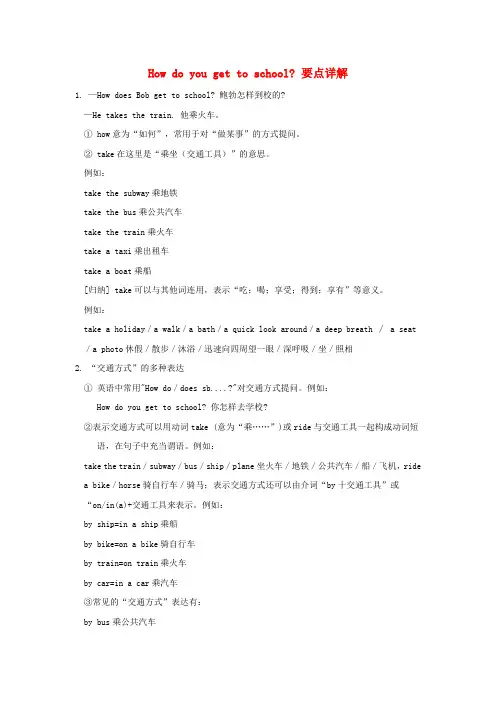
How do you get to school? 要点详解1. —How does Bob get to school? 鲍勃怎样到校的?—He takes the train. 他乘火车。
① how意为“如何”,常用于对“做某事”的方式提问。
② take在这里是“乘坐(交通工具)”的意思。
例如:take the subway乘地铁take the bus乘公共汽车take the train乘火车take a taxi乘出租车take a boat乘船[归纳] take可以与其他词连用,表示“吃;喝;享受;得到;享有”等意义。
例如:take a holiday/a walk/a bath/a quick look around/a deep breath ∕ a seat /a photo休假/散步/沐浴/迅速向四周望一眼/深呼吸/坐/照相2. “交通方式”的多种表达①英语中常用"How do/does sb....?"对交通方式提问。
例如:How do you get to school? 你怎样去学校?②表示交通方式可以用动词take (意为“乘……”)或ride与交通工具一起构成动词短语,在句子中充当谓语。
例如:take the train/subway/bus/ship/plane坐火车/地铁/公共汽车/船/飞机,ride a bike/horse骑自行车/骑马;表示交通方式还可以由介词“by十交通工具”或“on/in(a)+交通工具来表示。
例如:by ship=in a ship乘船by bike=on a bike骑自行车by train=on train乘火车by car=in a car乘汽车③常见的“交通方式”表达有:by bus乘公共汽车by train乘火车by ship/sea乘船by plane/air乘飞机by bike骑自行车by car乘小汽车on foot步行go to…by car=drive to…go to…by bike=ride to…go to…on foot=walk to…go to…by plane/air=fly to…3. It takes about forty minutes. 大约花费40分钟。

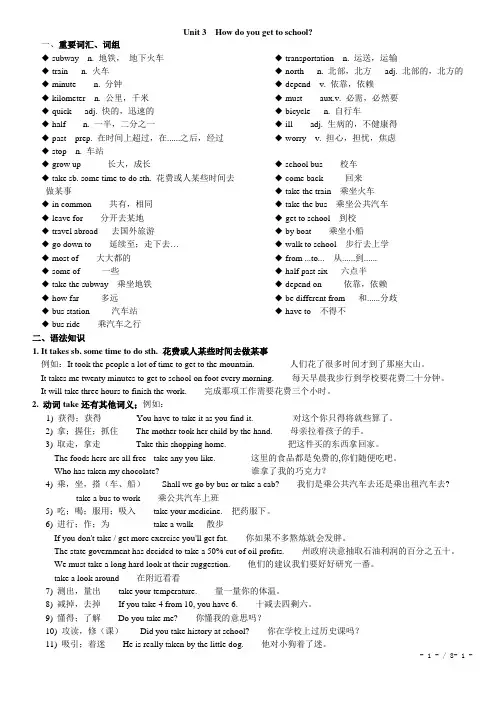
Unit 3 How do you get to school?一、重要词汇、词组◆ subway n. 地铁,地下火车◆ train n. 火车◆ minute n. 分钟◆ kilometer n. 公里,千米◆ quick adj. 快的,迅速的◆ half n. 一半,二分之一◆ past prep. 在时间上超过,在......之后,经过◆ stop n. 车站◆ transportation n. 运送,运输◆ north n. 北部,北方adj. 北部的,北方的◆ depend v. 依靠,依赖◆ must aux.v. 必需,必然要◆ bicycle n. 自行车◆ ill adj. 生病的,不健康得◆ worry v. 担心,担忧,焦虑◆ grow up长大,成长◆ take sb. some time to do sth. 花费或人某些时间去做某事◆ in common 共有,相同◆ leave for 分开去某地◆ travel abroad 去国外旅游◆ go down to延续至;走下去…◆ most of大大都的◆ some of一些◆ take the subway乘坐地铁◆ how far多远◆ bus station汽车站◆ bus ride乘汽车之行◆ school bus校车◆ come back回来◆ take the train乘坐火车◆ take the bus乘坐公共汽车◆ get to school到校◆ by boat乘坐小船◆ walk to school步行去上学◆ from ...to...从......到......◆ half past six六点半◆ depend on依靠,依赖◆ be different from和......分歧◆ have to不得不二、语法知识1. It takes sb. some time to do sth. 花费或人某些时间去做某事例如:It took the people a lot of time to get to the mountain.人们花了很多时间才到了那座大山。

新版新目标英语七年级下册unit3知识点总结Unit 3: How Do You Get to School?n A1.How do you usually get to school。
This XXX used to get to school。
There are different ways to answer this XXX:I walk to school。
This means that the person goes to school on foot.I XXX to school。
This means that the person uses a bike to get to school.I take the bus to school。
This means that the person uses a bus to get to school.I drive my car to work。
This means that the person uses a car to get to work.I fly to Shanghai。
This means that the person uses a plane to get to Shanghai.Note that when using "by" to XXX。
the noun should not be XXX。
it is possible to use verbs such as walk。
ride。
drive。
orfly followed by "to" and the name of the n.2.The verb "get" is often used with the n "to" to indicate the n。
However。
if the n is indicated by an adverb such as "here," "there," or "home," the n "to" is not XXX:I get to Beijing。
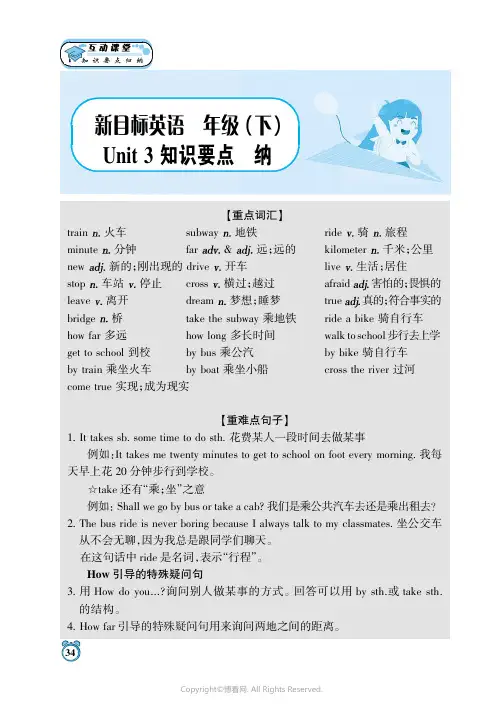
知【重点词汇】train火车subway 地铁ride 骑旅程minute 分钟far &远;远的kilometer千米;公里new 新的;刚出现的drive 开车live 生活;居住stop 车站停止cross 横过;越过afraid 害怕的;畏惧的leave 离开dream 梦想;睡梦true 真的;符合事实的bridge 桥take the subway 乘地铁ride a bike 骑自行车how far 多远how long 多长时间walk to school 步行去上学get to school 到校by bus 乘公汽by bike 骑自行车by train 乘坐火车by boat 乘坐小船cross the river 过河come true 实现;成为现实【重难点句子】1.It takes sb.some time to do sth.花费某人一段时间去做某事例如:It takes me twenty minutes to get to school on foot every morning.我每天早上花20分钟步行到学校。
☆take 还有“乘;坐”之意例如:Shall we go by bus or take a cab?我们是乘公共汽车去还是乘出租去?2.The bus ride is never boring because I always talk to my classmates.坐公交车从不会无聊,因为我总是跟同学们聊天。
在这句话中ride 是名词,表示“行程”。
How 引导的特殊疑问句3.用How do you...?询问别人做某事的方式。
回答可以用by sth.或take sth.的结构。
4.How far 引导的特殊疑问句用来询问两地之间的距离。
34Copyright ©博看网. All Rights Reserved.。

七年级英语下册第三单元知识点总结一、词汇与短语1. 动词- have:拥有,具有。
例如:I have a new book.(我有一本新书。
)- collect:收集。
例如:She collects stamps.(她收集邮票。
)- play:玩,演奏。
例如:I play the piano.(我弹钢琴。
)- show:展示,给……看。
例如:Can you show me your photos?(你能给我看看你的照片吗?)2. 名词- thing:事物,东西。
例如:What's that thing over there?(那边那个东西是什么?)- hobby:爱好。
例如:My hobby is reading.(我的爱好是阅读。
)- club:俱乐部。
例如:He is a member of the basketball club.(他是篮球俱乐部的成员。
)- story:故事。
例如:I like listening to stories.(我喜欢听故事。
)3. 其他- a lot of:许多,大量。
例如:She has a lot of friends.(她有很多朋友。
)- in one's free time:在某人的空闲时间。
例如:I often read books in my free time.(我经常在空闲时间读书。
)- be interested in:对……感兴趣。
例如:I'm interested in science.(我对科学感兴趣。
)二、语法与句型1. 一般现在时- 描述经常发生的动作或存在的状态。
例如:I usually go to school by bike.(我通常骑自行车上学。
)- 第三人称单数形式的变化:动词后加-s或-es。
例如:He watches TV every day.(他每天都看电视。
)2. 特殊疑问句- 结构:特殊疑问词+ 一般疑问句。
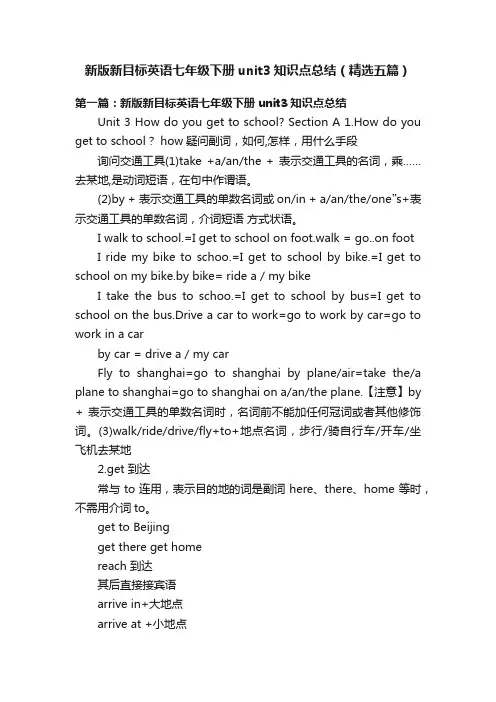
新版新目标英语七年级下册unit3知识点总结(精选五篇)第一篇:新版新目标英语七年级下册unit3知识点总结Unit 3 How do you get to school? Section A 1.How do you get to school? how疑问副词,如何,怎样,用什么手段询问交通工具(1)take +a/an/the + 表示交通工具的名词,乘……去某地,是动词短语,在句中作谓语。
(2)by + 表示交通工具的单数名词或on/in + a/an/the/one‟s+表示交通工具的单数名词,介词短语方式状语。
I walk to school.=I get to school on foot.walk = go..on footI ride my bike to schoo.=I get to school by bike.=I get to school on my bike.by bike= ride a / my bikeI take the bus to schoo.=I get to school by bus=I get to school on the bus.Drive a car to work=go to work by car=go to work in a carby car = drive a / my carFly to shanghai=go to shanghai by plane/air=take the/a plane to shanghai=go to shanghai on a/an/the plane.【注意】by + 表示交通工具的单数名词时,名词前不能加任何冠词或者其他修饰词。
(3)walk/ride/drive/fly+to+地点名词,步行/骑自行车/开车/坐飞机去某地2.get 到达常与to连用,表示目的地的词是副词here、there、home等时,不需用介词to。
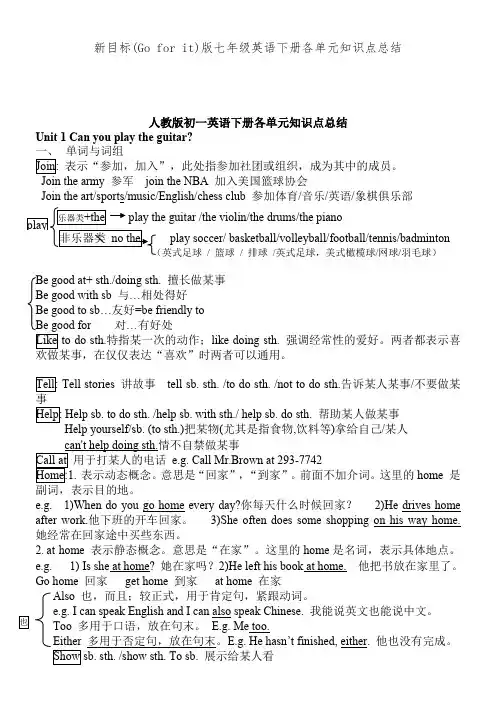
新目标(Go for it)版七年级英语下册各单元知识点总结人教版初一英语下册各单元知识点总结Unit 1 Can you play the guitar?一、 单词与词组表示“参加,加入”,此处指参加社团或组织,成为其中的成员。
Join the army 参军 join the NBA 加入美国篮球协会Join the art/sports/music/English/chess club 参加体育/音乐/英语/象棋俱乐部play soccer/ basketball/volleyball/football/tennis/badminton / 篮球 / 排球 /英式足球,美式橄榄球/网球/羽毛球)Be good at+ sth./doing sth. 擅长做某事Be good with sb 与…相处得好Be good to sb …友好=be friendly toBe good for 对…有好处特指某一次的动作;like doing sth. 强调经常性的爱好。
两者都表示喜讲故事 tell sb. sth. /to do sth. /not to do sth.告诉某人某事/不要做某帮助某人做某事Help yourself/sb. (to sth.)把某物(尤其是指食物,饮料等)拿给自己/某人e.g. Call Mr.Brown at 293-7742意思是“回家”,“到家”。
前面不加介词。
这里的home 是e.g. 1)When do you go home every day?你每天什么时候回家? 2)He drives home after work.他下班的开车回家。
3)She often does some shopping on his way home. 她经常在回家途中买些东西。
2. at home 表示静态概念。
意思是“在家”。
这里的home 是名词,表示具体地点。
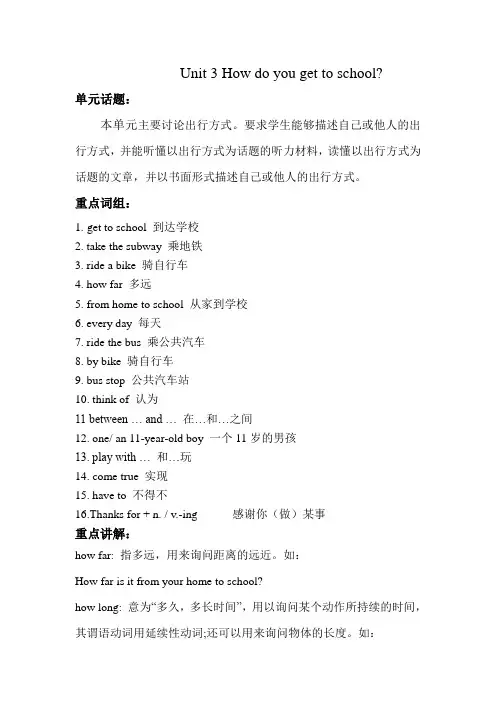
Unit 3 How do you get to school?单元话题:本单元主要讨论出行方式。
要求学生能够描述自己或他人的出行方式,并能听懂以出行方式为话题的听力材料,读懂以出行方式为话题的文章,并以书面形式描述自己或他人的出行方式。
重点词组:1.get to school 到达学校2. take the subway 乘地铁3. ride a bike 骑自行车4. how far 多远5. from home to school 从家到学校6. every day 每天7. ride the bus 乘公共汽车8. by bike 骑自行车9. bus stop 公共汽车站10. think of 认为11 between … and … 在…和…之间12. one/ an 11-year-old boy 一个11岁的男孩13. play with … 和…玩14. come true 实现15. have to 不得不16.Thanks for + n. / v.-ing 感谢你(做)某事重点讲解:how far: 指多远,用来询问距离的远近。
如:How far is it from your home to school?how long: 意为“多久,多长时间”,用以询问某个动作所持续的时间,其谓语动词用延续性动词;还可以用来询问物体的长度。
如:How long does it take you to get to school?between...and: 在……和……之间。
如:I sit between Tom and Helen. come true: 实现。
如:I think my dream can come true.重点句型:1. How do you get to school?2. How far is your from home to your school?3. But he is not afraid because he loves school.4. How long does it take you to get to school?这个句子中的take意为“花费”,一般指“花时间”,通常用于句型“It takes sb. some time(一段时间)to d o sth.”,意为“花费某人多长时间做某事”。
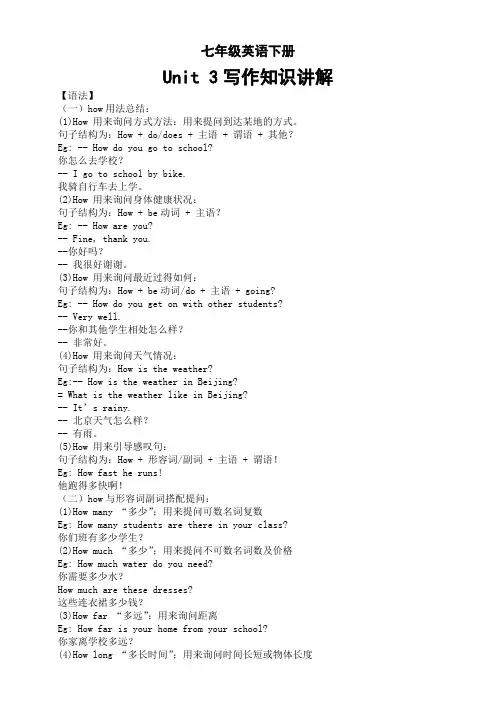
七年级英语下册Unit 3写作知识讲解【语法】(一)how用法总结:(1)How 用来询问方式方法:用来提问到达某地的方式。
句子结构为:How + do/does + 主语 + 谓语 + 其他?Eg: -- How do you go to school?你怎么去学校?-- I go to school by bike.我骑自行车去上学。
(2)How 用来询问身体健康状况:句子结构为:How + be动词 + 主语?Eg: -- How are you?-- Fine, thank you.--你好吗?-- 我很好谢谢。
(3)How 用来询问最近过得如何:句子结构为:How + be动词/do + 主语 + going?Eg: -- How do you get on with other students?-- Very well.--你和其他学生相处怎么样?-- 非常好。
(4)How 用来询问天气情况:句子结构为:How is the weather?Eg:-- How is the weather in Beijing?= What is the weather like in Beijing?-- It’s rainy.-- 北京天气怎么样?-- 有雨。
(5)How 用来引导感叹句:句子结构为:How + 形容词/副词 + 主语 + 谓语!Eg: How fast he runs!他跑得多快啊!(二)how与形容词副词搭配提问:(1)How many “多少”;用来提问可数名词复数Eg: How many students are there in your class?你们班有多少学生?(2)How much “多少”;用来提问不可数名词数及价格Eg: How much water do you need?你需要多少水?How much are these dresses?这些连衣裙多少钱?(3)How far “多远”;用来询问距离Eg: How far is your home from your school?你家离学校多远?(4)How long “多长时间”;用来询问时间长短或物体长度Eg: How long does it take you to get to school?你花多长时间到学校?How long is the ruler?这把尺多长?(5)How often “多久一次”;用来询问频率Eg: How often do you exercise?你多久锻炼一次?(6)How soon “多久之后”;用来询问时间段Eg: How soon will you be back?你多久回来?(7)How old “多大”;用来询问年龄Eg: How old are you ?你多大了?(8)How about “怎么样”;用来提建议或咨询建议Eg: How about this one?这个怎么样?【知识讲解】1.Drive作动词时,意为“开车;推动;驱赶”常用结构:drive sb.to 地点“某人开车去某地”Eg: My father drives me to school.“我爸爸开车送我去学校。
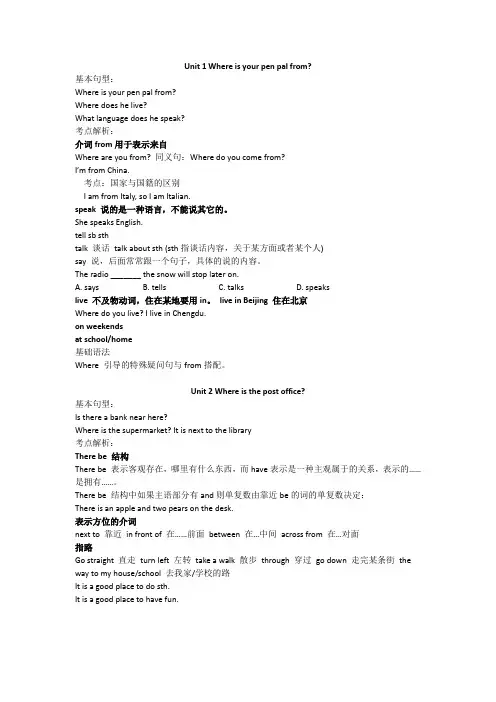
Unit 3 How do you get to school? 单元知识归纳【短语归纳】1.get to school 到达学校2.take the subway 乘地铁3.ride a bike 骑自行车4.how far 多远5.from home to school 从家到学校6.every day 每天7.take the bus 乘公共汽车 8.by bike 骑自行车8.bus stop 公共汽车站 9.think of 认为10.between …and …在…和…之间11.have to 不得不12.one 11-year-old boy 一个11岁的男孩(必须放于名词之前)13.play with …和…玩 e true 实现15.be afraid 害怕 16.be like 像……【用法集萃】1.take…to …= go to …by…乘……去……2.How do/does (sb)get to …? ……是怎样到……的?3.How far is it from …to …? 从……到……有多远?4.It takes sb. some time to do sth.做某事花费某人多长时间。
5.How long does it take …? ……花费多长时间?6.It is + adj. + to do sth. 做某事是……7.Thanks for + n./v.-ing 感谢你(做)某事。
8.have to + 动词原形不得不做某事9.What do/does + 主语 + think of…? ……认为……怎么样?【重点句子】1. How do you get to school? I walk to school.你是怎样到校的?我步行。
2. I usually walk but sometimes I take the bus.我通常步行,但有时坐公共汽车。
3. How long does it take you to get to school?It takes about 10 minutes to walk and 15 minutes by bus. 4. How far is it from his home to school? About 10 kilomete rs. 从他家到学校有多远?大约10公里。
《新目标英语》七年级下册重点句型、短语归纳Unit 1 Where’s your pen pal from?Ⅰ、Useful expressions:1. be from= come from 来自于2. New York 纽约3. the United States 美国4. he United Kingdom 英国5. one’s (new) pen pal 某人的(新)笔友6. in Paris 在巴黎7. want a pen pal 想要一个笔友8. a pen pal in China=a Chinese pen pal 一个在中国的笔友9. a very interesting country 一个非常有趣的国家10. in November 在十一月11.speak a little (French) 说一点儿法语12. like doing sth. 喜欢做某事13. go to the movies 去看电影14. in school / at school在学校里15. too difficult 太困难16. write to sb. (soon) = write a letter to sb (soon)(尽快)给某人写信17. pen pal wanted 征招笔友18. on weekends 在周末19. at school 在学校;在上学20. the long weekend 漫长的周末21. tell sb. about yourself 告述某人关于你自己的情况22.live in 居住在---23 .write to sb给某人写信;写信给某人24.in the world 在世界上25、in China 在中国26、one’s favorite subject 某人最喜欢的科目27.speak English 讲英语28、likes and dislikes 爱憎,好恶29、play sports 做运动Ⅱ、Sentences:1. Where is your pen pal from? 你的笔友来自哪儿?=Where does your pen pal come from?She’s from Japan. 她来自日本。
新目标七年级下Unit 3 知识点归纳与复习单元知识清单一、重点单词:1. t ger 老虎2. ele ant 大象3. p nd 熊猫4. l n 狮子5. z 动物园6. m p 地图7. an m l 动物8. b x 盒子9. s th 南方10. cl ver 聪明的11. fr ndly 友好的12. sh 害羞的13. ther 其它的14. gr ss 草15. sl p 睡觉16. l f 叶子17. l z 懒惰的18. m t 肉19. rel x 放松20. d ing 在……期间二、必会短语1. kind 有几分2. South 南非3. play 与……一起玩4. the day 在白天期间5. at 在夜晚三、应知语法和句式:1. 提问原因用why。
如:你为什么要去看狮子?do you want to see the lions?2. why 的同义词是:for3. 名词复数表示一类事物,注意谓语动词的形式。
如:狮子来自南非。
from South Africa.4. like to do sth 表示喜欢具体的某一次活动。
如:她今天喜欢去动物园。
She likes the zoo.like doing sth 表示喜欢某种活动,是一种爱好。
如:玲玲爱购物。
Ling Ling likes shopping.5. 否定式疑问句的答语。
如:Isn’t he cute?肯定回答:, . 不, 他可爱。
否定回答:, . 是,他不可爱。
知识点1 词语运用Ⅰ. 根据句意和首字母完成下列单词。
1. I like pandas. They are cute and they are from C .2. There are many kinds of a in the zoo.3. A lion is a s animal. All the people are afraid (害怕) it.4. My friend Linda is a little s . She doesn’t like to talk to others.5. He likes music b it’s relaxing.6. When do you go to s at night? Do you get up early?7. L on the trees (树) are favorite food for koalas to eat.8. Chinese people are very f to visitors (游客).9. A g has a long neck(脖子). It’s a beautiful animal.10. E is a very big animal, with two teeth and a long nose.Ⅱ.根据汉语提示及句意完成句子。
新目标go,for,it,七年级下册单元单词及知识点篇一:新版新目标英语七年级下册各单元知识点汇总新版新目标英语七年级下册各单元知识点汇总Unit 1 Can you play the guitar1. guitar为一种乐器,注意play与表示乐器的名词连用时,前要加定冠词the。
2. join意为―参加(某个组织成为其成员)‖,一般常和介词in连用。
3. have a swim游泳;go swimming去游泳4. ―下棋‖用play chess,而不用play the chess。
5. Painted 派生词:painter n.画家 painting n.画(注意与draw的区别: paint指用颜料等绘画;而draw指用钢笔、铅笔等画。
)6. 注意区分:speak,say,talk和tella) ①say指用语言表达思想,着重说话的内容或强调说话这一动作,不表示说话的性质。
b) ②speak强调说话的动作、声音,而不强调内容。
在正式场合表示发言、演讲,说某种语言用speak。
c) ③talk表示两个人或多个人在一起讲话、谈论(多指随意谈论)。
d)④tell的意思是―告诉,讲述,吩咐‖,讲故事或讲笑话多用tell。
7. 弹钢琴要用play the piano,其中定冠词the不能省略。
8. Show 用法:show作动词,意为―表演,演出,出示……给某人看‖,有时与介词搭配使用,构成show sth. to sb.=show sb. sth.。
show作名词,意为―展览,展出‖。
构成短语on show,意为―在展出‖。
9. 表示―在星期几‖要用介词on。
如:on Sunday―在星期日‖。
10. Little 用法:1)little还有―小的,小巧的‖之意,带有小的可爱之意。
2)注意little与a little 的区别:little与a little都可表示数量,修饰不可数名词。
但little表示否定意义,而a little表示肯定意义。
七年级英语下册Unit 3知识点【Useful expressions】1.get to school 到达学校2.take the subway 乘地铁3.take the train 乘火车4.take a car 坐小汽车5.take a taxi 乘坐出租车6.take the plane 乘飞机7.take the bus 乘公共汽车8.by bike 骑自行车9.ride a bike 骑自行车10.how far 多远11.from home to school 从家到学校12.every day 每天13.bus stop 公共汽车站14.think of 认为15.between…and…在…和…之间16.one 11-year-old boy 一个11岁的男孩17.play with…和…玩e true 实现19.have to 不得不20.leave home 离开家21.cross the river 过河22.be afraid of 害怕23.be like 像...【Target sentences】How do you get to school?— I ride my bike.2.— How long does it take to get to school?— It takes about 15 minutes.3.— How far is it from your home to school?—It’s only about two kilometers.4.—Does Jane walk to school?—No, she doesn’t.She goes by bike.5.—Do they take the bus to school?—No, they don’t.They walk.6.I ride my bike to the subway station.Then I take the subway.7.Mary wants to know where Bob lives.8.Mary wants to know how far he lives from his grandparents’ ho me.9.For many students, it is easy to get to school.10.There is a very big river between their school and the village.11.One 11-year-old boy, Liangliang, crosses the river every school day.12.But he is not afraid because he loves school.13.He’s li ke a father to me.【Language points】1.take the subway 乘地铁take作动词,意为“乘坐”。
Unit3 How do you get to school?【重点单词】train [treɪn] n. 火车bus [bʌs] n. 公共汽车;公交车subway ['sʌbweɪ] n. 地铁take the subway 乘地铁ride [raɪd] v. 骑n. 旅程bike [baɪ k] n. 自行车ride a bike 骑自行车sixty ['sɪkstɪ] num. 六十seventy ['sevntɪ] num. 七十eighty ['eɪtɪ] num. 八十ninety ['naɪntɪ] num. 九十hundred ['hʌndrəd] num. 一百minute ['mɪnɪt] n. 分钟far adv.&adj远;远的kilometer n.公里new adj.新的;刚出现的every adj.每一;每个every day 每天by prep.(表示方式)乘(交通工具)by bike 骑自行车drive v.开车car n.小汽车;轿车live v.居住;生活stop n.车站;停止think of 认为cross v.横过;越过river n.河;江many adj.&pron.许多village n.村庄;村镇between prep.介于…之间between…and…在……和……之间bridge n.桥boat n.小船Ropeway n.索道year n.年;岁afraid adj.害怕;惧怕like prep.像;怎么样leave v.离开dream n.梦想;睡梦v.做梦true adj.真的;符合事实的come true 实现;成为现实【重点短语】1. get to school 到达学校2. take the train 乘火车3. take the subway 乘地铁4. ride a bike 骑自行车5. how do you get to school 怎么到达学校6. one hundred and five 1057. how far 多远8. how long 多长时间9. it takes sb some time to do sth 它花费某人多长时间做某事10. ride the bike to school 骑自行车到学校11. walk to , drive to ,fly to…步行去…;开车去…;坐飞机去….12. every day 每天13. I’m not sure 我不敢确信14. about= around 大约15. 10 kilometers 十公里16. good exercise 好的锻炼17. drive his car to work 开车去上班18. in his father’s car 坐父亲的车19. need about 10 minutes to get to school 需要十分钟的时间到达学校20. what do you think of…=how do you like…你觉得怎么样21. cross the river 过河22. It is easy to get to school. 到达学校很容易。
Unit 3 How do you get to school?Section A1.How do you get to school?how疑问副词,如何,怎样,用什么手段询问交通工具(1)take +a/an/the + 表示交通工具的名词,乘……去某地,是动词短语,在句中作谓语。
(2)by + 表示交通工具的单数名词或on/in + a/an/the/one’s+表示交通工具的单数名词,介词短语方式状语。
I walk to school.=I get to school on foot. walk = go ..on footI ride my bike to schoo.=I get to school by bike.=I get to school on my bike. by bike= ride a / my bikeI take the bus to schoo.=I get to school by bus=I get to school on the bus.Drive a car to work=go to work by car=go to work in a car by car = drive a / my carFly to shanghai=go to shanghai by plane/air=take the/a plane to shanghai=go to shanghai on a/an/the plane. 【注意】by + 表示交通工具的单数名词时,名词前不能加任何冠词或者其他修饰词。
(3)walk/ride/drive/fly+to+地点名词,步行/骑自行车/开车/坐飞机去某地2. get 到达常与to连用,表示目的地的词是副词here、there、home等时,不需用介词to。
get to Beijing get there get homereach 到达其后直接接宾语arrive in+大地点arrive at +小地点后接副词不需介词3. How far is it from A to B?=How far is B from A? 从A到B有多远?答语(1)It’s…meters/miles/kilometers(away) from... 有……米/英里/千米(远)(2)It ‘s about ten minutes’ walk/ ride. 大约有十分钟步行/骑车的路程。
(3)It ‘s far/near.be far from, away from, from ..to .be far from, 离…远My school is far from my home.具体路程+away from My school is 10 kilometers away from my home.from…to…从…到…It’s 10 kilometers (away) from my school to my home.A +be +路程距离from +B My school(A)is 10 kilometers from my home(B).4.How long does it take you to get to school? how long 提问时间,多久How long have you been in America?For two years.5. take spend cost pay(1)spend 主语必须是人Sb spend some time/money on sth 某人在某事或某物上花费时间/钱Sb spend some time/ money (in)doing sth 某人花时间/金钱做某事(2)cost主语只能是事情。
sth cost sb some money某物花费某人多少钱The skirt costs her 200 yuan.(3)pay主语必须是人sb pay some money for sth.某人为某物付款/花费多少钱He paid 1000 yuan for the TV set.(4)take 主语必须是it It takes sb some time( money) to do sth. 做某事花费某人多长时间It took him seven days to make the big cake.6. around(1)环绕;围绕;绕过The earth moves around the sun.(2)在…四周There are many trees around the playground.(3)在…的附近Is there a park around here ?(4)大约=about 常与数字连用at about/around 8 o’colck7.live v 居住,生活(1)live on sth 以某物为食(2) live a ...life 过...生活Section B1.bus stop 车站,站点城镇内外的停车点bus station 能停,转车辆的汽车站点at the bus stop2.What do you think of/about ...? =How do you like...? 你认为.....怎么样?询问某人看法的句型3.cross crossing across(1)cross v 穿过,横穿、交叉He crossed the Yellow River yesterday.昨天他横渡了黄河。
The two streets cross in the centre of the city.两条街在市中心交叉。
(2)crossing n 十字路口,交叉,十字形复数形式为crossesMr Li marked the paper with a cross.李老师在试卷上打了一个叉。
You can turn left at the second crossing.你可以在第二个十字路口向左拐。
(3)across prep 穿过cross=go acrossShe crossed the river yesterday.She swam across the river yesterday.(4)across与through穿过, 但across指从物体表面上过去,而through指物体内部空间穿过go across the bridge. 走过那座桥swim across the river游过河去walk through the forest步行穿过了森林4.no作形容词来修饰名词修饰单数可数名词时,no=not a/an修饰复数可数名词或不可数名词时,no=not anyThere is no bridge.=There is not a bridge.I have no problems.=I don’t have any problems.5.11-year-old是复合形容词,作定语,修饰名词boy,11岁的数词+名词(+形容词)构成的复合形容词中,名词只能用单数形式。
an 8 -year-old boy一个8岁的男孩6. be afraid to do害怕做某事,是主观上的原因不去做,怕be afraid of doing唯恐做某事,担心做某事会引起某种后果be afraid of sth 害怕某物/某事be afraid that从句恐怕She was afraid to wake her husband. 她不敢去叫醒她丈夫。
She was afraid of waking her husband.她生怕吵醒她丈夫。
7.leave vt. 离开(1)leave for 前往某地,动身去某地(2) 听任,使处于某种状态leave the windows open. 让窗子开着(3) 遗忘;留下,落下leave sth 介词sp(4) 辞去(工作等);脱离(组织等) Mary left school last year and she is working in a shop now.8.dream of/about 梦想,梦见come true 实现,成为现实9.have to 后加动词原形,侧重客观的需要,不得不,被迫,有多种时态形式否定式为don’t have to(needn’t)不必must 侧重于说话者的主观看法,认为有必要或有义务做某事,只有现在时一种形式,否定式must’t不准,禁止10. Thanks for...=Thank you for...谢谢你语法1.how 引导的特殊疑问句提问交通方式,其答语分三种情况:(1)take a/an/the+交通工具(单数)(2) by+交通工具(单数)(3) on/in+限定词+交通工具2. how far 用来提问距离,多远,其答语分为两种:(1)用长度单位表示:It is five kilometers.(2)用时间表示:It’s twenty minutes’ walk.3.how long 用来提问时间,多久回答常用for+段时。
How long have you learnt English?For 3 years.4. how soon 用来提问做完某事还需要多长时间,常用于将来时态时,常用in+时间段来回答。
How soon will you arrive in Beijing?-In 3 hours.5.感谢用语Thank you very much , Thanks a lot , Many thanks.That’s ok /all right. 不用谢。
You are welcome 不客气。
It is my pleasure./My pleasure./It is a pleasure.不客气、那是我的荣幸。
Don’t mention it。
别在意。
It was nothing at all.那没什么6.take,bring与fetchtake 带走,拿走,强调从说话地将人和物带走别的地方去bring 带走,强调将某人或某物从别的地方带到说话地来fetch 去拿,去取,即离开说话地去取某物后再回来,强调动作的往返7.say speak talk tellsay 说,讲,它针对的是说话的内容speak 说,讲,不强调说话的内容,但有时指讲某种语言,(在会上)发言要用speaktell 说;告诉,侧重于“告诉”的含义多一些,tell sb about sth 告诉某人关于某事tell sb (not )to do sth 告诉某人(不要)做某事talk 谈话;交谈,有不及物动词和名词两种词性,常与with,about或to搭配8.look read see watchlook 看,强调看的动作,多以词组形式出现,如look at, look like,.look after等read 读,多指看书、看报、看杂志、看图等see 看见,看到,侧重于看的结果,常用句式:see sb do/doing sthwatch 观看,注视,指非常仔细地、有目的地、特定地看,多接比赛、电视。